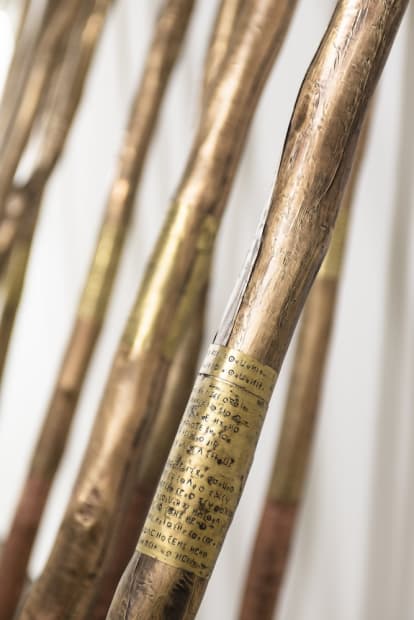-
Now the possible is other than it was before
Nothing retains its own likeness
This is the character of the earth.
Lisa Robertson[1]
M’barek Bouhchichi once told me a haunting tale from Tinghir, a small town in the south east of Morocco. It is the story of a khammas [sharecropper] nicknamed Kizitt, who had vowed to remain celibate. When asked for his reasons, he had only one answer: “Sharecropper, son of a sharecropper, grandson of a sharecropper… I am putting an end to this lineage”.
Etymology is hesitant when it comes to the Haratin (sing. Hartani). The term may describe a function (Arabic ‘harrathine’: land workers), a legal state (Arabic ‘hurr thani’: freed slave or second-order free man) or a skin color (Amazigh ‘Ahardan’: dark color). In the Drâa valley a strict economic order has long banned the Haratin from land ownership, thus subordinating them to other social groups. They toil on the properties of “white” landlords for one fifth of the yield.
[1] Lisa Robertson, “Earth in Lucretius”, in tamawuj.org, 2017.
-

M'barek Bouhchichi
Sharecropper, 2019
-
![Popular poetry in Morocco was always tightly linked to nature. In the words of Ahmed Bouanani, “some believe [the poet]...](data:image/gif;base64,R0lGODlhAQABAIAAAAAAAP///yH5BAEAAAAALAAAAAABAAEAAAIBRAA7) M'barek Bouhchichi, L'mdyazen #3, 2018
M'barek Bouhchichi, L'mdyazen #3, 2018Popular poetry in Morocco was always tightly linked to nature. In the words of Ahmed Bouanani, “some believe [the poet] is in touch with natural forces, that he can appease them or set them against an enemy, that he speaks the language of animals, plants, and insects. The world has no secrets for him.”[1] True to tradition, Ben Zida’s poetry brims with “natural” metaphors. But in using them to protest the social condition of black Moroccans, he made the soil speak a language it had never spoken.
Deleuze and Guattari remind us that there is also a fundamental link between soil and metallurgy. “The metallurgist is the first specialized artisan, whose sustenance is made possible by the formation of an agricultural surplus. The relation of the smith to agriculture has to do not only with the tools smiths manufacture but also with the food they take or receive.”[2] Not to mention that the metal they work with is itself extracted from underneath the soil. For Bouhchichi, southern smiths, who like the khammasa are most often black-skinned, are poets in their own right. In Greek poiein is to make, to create, to fabricate, to shape. Blacksmiths are magic forgers of form. They breathe new life into matter. With fire and metal, they make, unmake, and remake forms by melting and shaping and welding. Their work is a constant reminder that nothing is definitive or unchangeable.
[1] A. Bouanani, “Introduction à la poésie populaire marocaine”, Souffles #3, 1966.
[2] G. Deleuze & F. Guattari, A Thousand Plateaus, trans. Brian Massumi, U. of Minnessota Press, 1987, p. 412.
-
By shedding new light on black life in the Moroccan south, M’barek Bouhchichi symbolically unsettles the existing divisions of space and labor. He samples social observations and converts them into physical forms. This could be called a conceptual materialism. Bouhchichi’s work displays a belief in matter—earth, soil, wood, metal—, a belief that matter, in its quality of presence and its shape-shiftiness, holds a potential for redemption.
This project brings together soil (agriculture), craft (metallurgy), and poetry (protest, worldmaking). It relies on a crude aesthetics that keeps it close to the earth. Bouhchichi’s work stages an interplay between the physical and the intangible. The very word “terre”, referring both to material soil and emotional land, refuses the neat division between materiality and affect. It is through this subtle wavering that Bouhchichi is able to open up the question of representation. His objects may be read as explicit social commentary; more poignantly, they are implicit portraits of a people.
There is an air of modernist seriality to this work, which comes just as surely from Bouhchichi’s interest in traditional craft that values subtle variation within repetition. Of this, traditional Berber poetry offers yet another model. Its very name, tandamt, carries the notion of order and pattern, which regular prosody embodies. The greatest poets, however,
are those who consistently surprise their listeners from within established conventions. Ben Zida was one such wordsmith. He exemplifies the possibility of singularity emerging from an overdetermined social space. He has known famine and exile, as well as humiliation on the part of white men[1]. He offers a model of liberation, albeit in a tragic key. For M’barek Bouhchichi, Ben Zida is a predecessor, but also a companion, an ally in the struggle for self-affirmation: a witness to Bouhchichi’s witnessing of a people and a culture.
[1] “Whenever I am tempted to curse the whites / a craving for dates commands I keep quiet / the whites hate to see the Issukin rise / they make them live a low humiliated life”
-

L'mdyazen #3, 2018 - Artwork detail
-

M'barek Bouhchichi
Etude pour un monument, 2019
Memory into Matter: M’barek Bouhchichi’s Conceptual Materialism a text by Omar Berrada
Previous viewing_room

![Popular poetry in Morocco was always tightly linked to nature. In the words of Ahmed Bouanani, “some believe [the poet]...](https://artlogic-res.cloudinary.com/w_3000,c_limit,f_auto,fl_lossy,q_auto/ws-selmaferianigallery/usr/images/feature_panels/image/items/9b/9b146f793f844d099fdc11d06b3033d3/_dsc2302.jpg)


